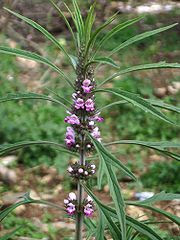 Scientific classification
Scientific classificationKingdom: Plantae
(unranked): Angiosperms
(unranked): Eudicots
(unranked): Asterids
Order: Lamiales
Family: Lamiaceae
Genus: Leonurus
Species: L. sibiricus
Binomial name
Leonurus sibiricus L.
Description
Leonurus sibiricus is a herbaceous annual or biennial with upright stems that grow from 20 to 80 cm tall. Plants have long petioled basal leaves, that are ovate-cordate in shape. The leaves have toothed margins and are incised with deeply cut lobes. Typically one or a few flowering stems are produced from short tap-roots. The lower stem leaves are deciduous and wither away as the plants begin blooming. The petioles of the leaves, midway up the stems are 2 cm long. The flowers are produced in many flowered verticillasters, produced in whorls around the top half or more of the stem. The flowers are sessile with 8 mm long calyxs that are tubular-campanulate in shape. The corolla is white or reddish to purple-red, with an upper lip that is oblong in shape and longer than the lower lip. When flowering is done, brown oblong shaped nutlets are produced in good number.[2] Blooming occurs from July into late September, but when climate permits, flowering can occur year round.[3][4]
This species habitat within its natural range, is stony or sandy grasslands or pine forests.[5]
Alkaloids
Leonurine is one of the active components of Leonurus sibiricus[6]
Alkaloids isolated from the plant include:[7]
* Leonurinine
* Leonuridine
* Stachydrine [1]
* Leuronurine
* Prehispanolone [2]
* Cycloleonurinine
* Leoheterin
* Preleoheterin
References
- ^ "PLANTS Profile for Leonurus sibiricus (honeyweed)". plants.usda.gov. http://plants.usda.gov/java/profile?symbol=LESI. Retrieved on 2008-12-04.
- ^ "Leonurus sibiricus in Flora of China @ efloras.org". www. efloras. org. http://www.efloras.org/florataxon.aspx?flora_id=2&taxon_id=200019765. Retrieved on 2008-12-04.
- ^ http://www.archive.org/stream/floraofstcroixvi00egge/floraofstcroixvi00egge_djvu.txt
- ^ http://whqlibdoc.who.int/wpro/1994-99/9290611200.pdf
- ^ "Leonurus sibiricus in Flora of China @ efloras. org". www. efloras.org. http://www.efloras.org/florataxon.aspx?flora_id=2&taxon_id=200019765. Retrieved on 2008-12-04.
- ^ "The Leonurine and its preparation" (in English). An Hui New Star Pharmaceutical Development Co.. 2008. http://www.newstar-chem.com/english/display.asp?id=208. Retrieved on 2008-08-28.
- ^ "Leonurus sibiricus L. Labiatae Korean Name: Ik-mo-cho English Name: Motherwort Parts used. Herb. Traditional uses.". 74.125.95.132. http://74.125.95.132/search?q=cache:SAxYdHmAIPUJ:www.wpro.who.int/internet/files/pub/97/161.pdf+%22Leonurus+sibiricus%22+alkaloids&hl=en&ct=clnk&cd=7&gl=us. Retrieved on 2008-12-04.

Tidak ada komentar:
Posting Komentar